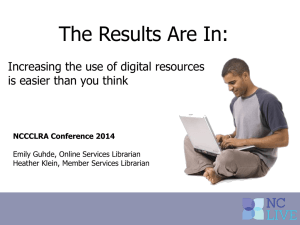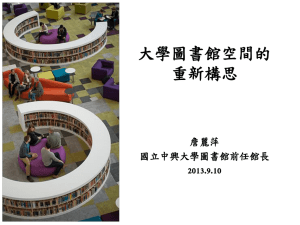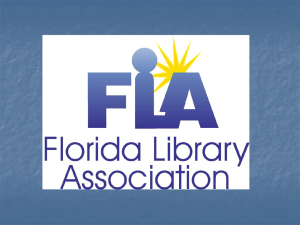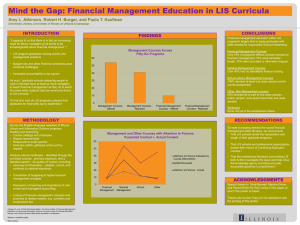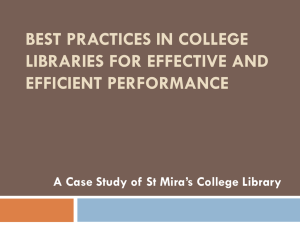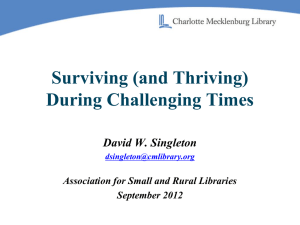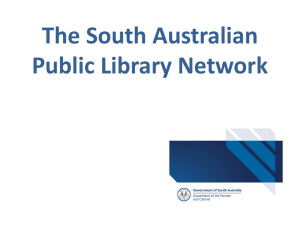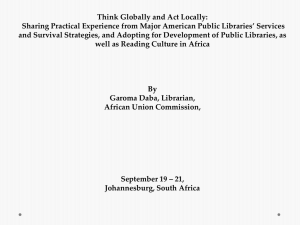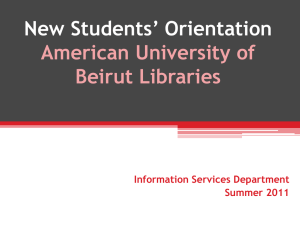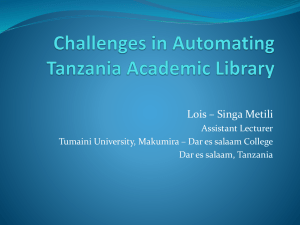From “outreach” to new library model
advertisement
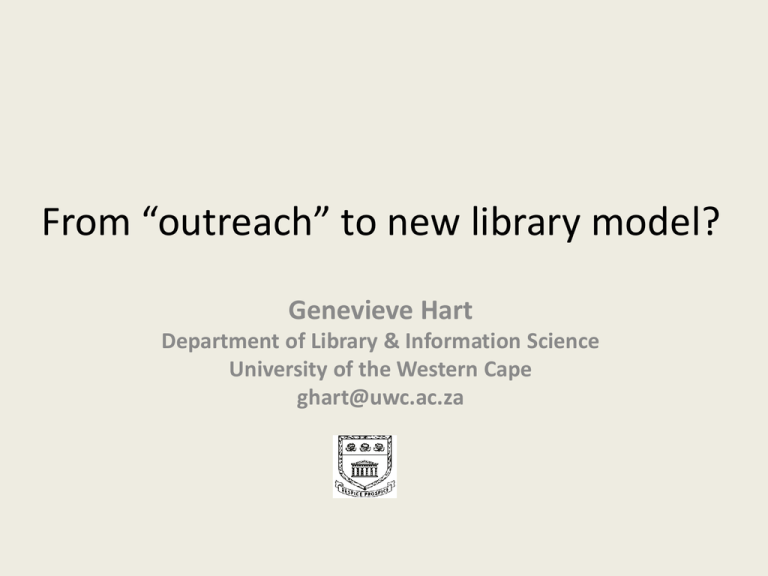
From “outreach” to new library model? Genevieve Hart Department of Library & Information Science University of the Western Cape ghart@uwc.ac.za From “outreach” to new library model • • • • • Context: South Africa’s poverty gap LIS Transformation Charter vision MDGs Libraries, social capital & sustainable development Bridging the vision gap – A glimpse of two case studies – New models of service? 2 South Africa’s poverty gap • Biggest barrier to knowledge economy? • Gini coefficient = 0.679 – “the most unequal society in the world with a significant increase in income inequality” UCT Development Policy Research Unit, 2009 • 10% of South Africans use the Internet • Castells’ “network society” & “fourth world” – “Informationalism is intertwined with rising inequality & social exclusion throughout the world” (1998) 3 Bridging the digital divide? Mapping ICT Access in South Africa. HSRC, 2007 • Libraries are community information sources • Public libraries: “Widest spacial distribution of public ICT service centres” • Libraries teach “information-management skills” • Libraries teach literacy: “essential skill to unlock the information & opportunities of the Internet” 4 LIS Transformation Charter (LTC) vision for SA libraries • “forces for social cohesion and justice” • “within reach of all” • “places for everyone” 5 Library burnings 6 Picture: Kevin Sutherland LIS realities • 8% schools have functioning library (DoE, 2007) • Libraries almost all in suburban ex-Model C (ex-white) schools • Public libraries are unevenly distributed: hardly any in ex- “homelands” • On average, less than 10% S Africans use public libraries • 70% public library users are school learners • 74% public libraries lack internet access 7 Libraries’ irrelevant? Charter’s question: “How can South Africans value something they have no use for?” 8 LTC vision “the [LIS] model is developmental, in keeping with the socio-economic context and UNESCO’s Millennium Development Goals ” 9 UN Millennium Development Goals www.un.org.millenniumgoals/ 1. 2. 3. 4. 5. 6. 7. 8. Eradicate extreme poverty & hunger Achieve universal primary education Promote gender equality & empower women Reduce child mortality Improve maternal health Combat HIV/AIDS, malaria .. Ensure environmental sustainability Global partnership for development : – – – Fair trade Development aid Spread benefits of ICT 10 “Developmental” public library? Where is the evidence? ? Development 11 Social capital “the stocks of social trust, norms & networks that people can draw upon to solve common problems” (Civic Practices Network, 2004) “bonding & bridging connections” 12 “Developmental” public library relies on AND builds stocks of social capital Social capital Social development 13 Public libraries: agents of social capital? • Educating: formal & informal • Developing informed citizens • Promoting tolerance – open & free access – to ideas & debate • Building bonding & bridging social capital – Library / community organisations 14 New models? Case studies of 2 prizewinning LIS 1. Six dual-use school / community libraries in Ex- “homeland” 2: Social capital in Fish Hoek /Masiphumelele Libraries 15 1. LIS Transformation Charter on dual use • “In some communities, education and community LIS authorities might together establish dual use school community libraries” • “The principles for an effective school LIS … cannot be ignored. Research is needed to assess whether South African dual use LIS conform to these fundamental principles” 16 Rural? “Immense & densely peopled townships placed far from economic opportunities” Butler 2004 17 But by 2009 Development: Commerce Industry Government bureaucracy 18 CBD public library Serves 200+ schools 19 20 • 2001-2004: 6 school community libraries set up with donor funding • Now run by provincial public library services 21 School community libraries’ goals • increasing numbers of libraries and reaching out to the people • providing electronic access to information • improving study facilities • broadening the scope of services offered • teaching people how to use information to their benefit, this creating an environment supportive of sustained economic, social and civic development. 22 Dual use 23 School or public library? Under-use by adult community? “What I have observed – the community do suffer a bit. It’s mostly used by the schools. But you know it’s something that happens in our black communities. They – the adults are not using libraries. We are still trying to teach them that they use libraries for all their information needs. But it’s the culture that is going on in our black community” Public Library Regional Director … 24 Principal 2 “I agreed to the project [dual use] because we have a problem of learners who cannot read, cannot ..get information. …They will take it [information] as it is. But now as we go on, they’re improving…. They have to read and summarize and give their point of view, not copying the stuff from the document.” 25 GH But who’s taught them that? What’s changed? Principal: “The librarian. The librarians are helping us a lot” 26 2. Study of LIS social capital Masiphumelele Satellite Library Fish Hoek Library 27 Fish Hoek Library Friends of the Library book shop 28 29 Demographics MasiCorp (www.masicorp.org/ ) • • • • 25,000 (8,242 in 2001) 10% houses; rest shacks 50% unemployed 23% HIV positive 30 Masiphumelele Library Outreach building (opening in March 2010) Library 31 32 33 “Outreach” open day 34 Upstairs computer room (Computer classes 3 mornings a week) 35 Some concluding questions • Can these models make a reality of Charter’s vision? 36 How sustainable is each model? • What are the risks? • In Case 1, can such a one-sided partnership last? • The library in Case 2 is a focal point for bridging capital. How much does it contribute to social capital within its own community? • When does “outreach” become owned by library authorities? Given the private funding, does it need to be? 37

